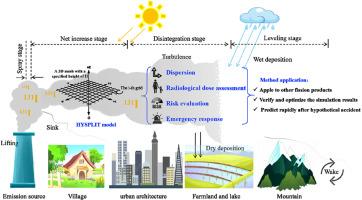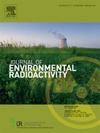Dispersion, radiological dose assessment, risk evaluation, and emergency response of radioactive materials based on WRF-HYSPLIT modeling
IF 2.1
3区 环境科学与生态学
Q3 ENVIRONMENTAL SCIENCES
引用次数: 0
Abstract
Accurate prediction of radionuclide dispersion is essential for radiation hazard prevention, yet predictive studies remain limited. This study employed the weather research and forecasting (WRF) model to generate a high-resolution meteorological data for the hybrid single particle lagrangian integrated trajectory (HYSPLIT) model to simulate the atmospheric transport of iodine-131 (131I). The calculation results of the real-time impact of radioactive emissions were obtained by first solving the gridded standard response distribution, then multiplying the coefficients according to the actual emission situation. Results revealed that the diffusion range of the nuclide 131I in the horizontal direction increased rapidly with the increase of altitude. Horizontal diffusion peaked at 1500 m altitude and declined above 2000 m, while vertical transport reached 1000 m within 2 h and 2000 m by 8 h, with effects lasting over 720 h. Deposition peaked 8 h post-release, particularly between 100 and 1000 m. Integrated dose assessment across multiple exposure pathways (e.g., dry/wet deposition and inhalation) showed negligible differences between adults and children, supporting unified evacuation planning. This study also revealed the potential threats to human health posed by various radiation dose pathways, such as environmental immersion external exposure, dry deposition, wet deposition external exposure, and internal exposure. Emergency response zones and timeframes were defined using international atomic energy agency (IAEA) standards. Though focused on 131I, the approach applies to other fission products. In addition, by combining field monitoring data and remote sensing technology to verify and optimize the simulation results, not only can the impact be calculated quickly after a real nuclear accident, but also the impact can be predicted rapidly after a hypothetical accident, which significantly improve the reliability and practicality of the emergency response plan.

基于WRF-HYSPLIT模型的放射性物质弥散、辐射剂量评估、风险评估和应急响应
准确预测放射性核素弥散对预防辐射危害至关重要,但预测研究仍然有限。本研究利用天气研究与预报(WRF)模式生成高分辨率气象数据,用于混合单粒子拉格朗日积分轨迹(HYSPLIT)模式模拟碘-131 (131I)的大气输送。首先对网格化标准响应分布进行求解,然后根据实际排放情况进行系数相乘,得到放射性排放实时影响的计算结果。结果表明,随着海拔的升高,131I核素在水平方向上的扩散范围迅速增大。水平扩散在海拔1500 m达到峰值,在海拔2000 m以上下降,而垂直输送在海拔2 h内达到1000 m, 8 h达到2000 m,持续时间超过720 h。沉降在释放后8 h达到峰值,特别是在海拔100 - 1000 m之间。跨多种暴露途径(如干/湿沉积和吸入)的综合剂量评估显示,成人和儿童之间的差异可以忽略,支持统一的疏散规划。本研究还揭示了环境浸没外照射、干沉降外照射、湿沉降外照射和内照射等多种辐射剂量途径对人体健康的潜在威胁。根据国际原子能机构(原子能机构)的标准确定了应急响应区域和时限。虽然重点是131I,但这种方法也适用于其他裂变产物。此外,通过结合现场监测数据和遥感技术对模拟结果进行验证和优化,不仅可以快速计算出真实核事故后的影响,还可以快速预测出假想事故后的影响,显著提高了应急响应方案的可靠性和实用性。
本文章由计算机程序翻译,如有差异,请以英文原文为准。
求助全文
约1分钟内获得全文
求助全文
来源期刊

Journal of environmental radioactivity
环境科学-环境科学
CiteScore
4.70
自引率
13.00%
发文量
209
审稿时长
73 days
期刊介绍:
The Journal of Environmental Radioactivity provides a coherent international forum for publication of original research or review papers on any aspect of the occurrence of radioactivity in natural systems.
Relevant subject areas range from applications of environmental radionuclides as mechanistic or timescale tracers of natural processes to assessments of the radioecological or radiological effects of ambient radioactivity. Papers deal with naturally occurring nuclides or with those created and released by man through nuclear weapons manufacture and testing, energy production, fuel-cycle technology, etc. Reports on radioactivity in the oceans, sediments, rivers, lakes, groundwaters, soils, atmosphere and all divisions of the biosphere are welcomed, but these should not simply be of a monitoring nature unless the data are particularly innovative.
 求助内容:
求助内容: 应助结果提醒方式:
应助结果提醒方式:


